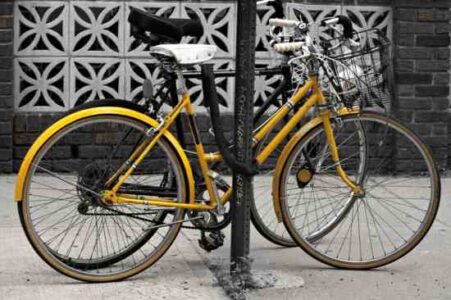Reposted with permission fromUrban Velo.
Theft is a very real problem for the urban cyclist. Nearly everyone has a story of a bike being stolen, with far fewer triumphant tales of reunion. Keep your stuff locked up if you want to ride it tomorrow.
This is easier said than done. Everything from hardware store cable on up to the boutique bicycle locks are marketed as “high security.” One is clearly a better choice than the other, with plenty of middle ground. The right choice for you is a lock just a bit better than the next person’s — cut-throat, yes, but tactically effective.
Check your surroundings. If everyone else has a high-end U-lock and you’ve got a cable, kiss your bike goodbye. There is a reason the everyday riders of New York carry around those giant Kryptonite chains, and it’s not just ‘cause it looks cool. Make sure your stuff is at least on par with what the knowledgeable locals use. Cheaping out on a lock isn’t worth it.
Besides just locking up in the first place, technique is more important than given lock model. This includes how you lock, and what you lock to. Lock the frame; no excuses. Don’t loop it through just a bolt-on wheel, or the seat post, stem or some other removable component. Do make sure that what you’re locking to is sturdy. Your fancy lock is only as good as what it’s locked to — lock onto a chain-link fence and you might as well tie up your bike with a length of wire. Give whatever you’re locking to a shake to make sure it’s soundly connected to — and can’t be unbolted from — the ground to slide your lock off. A tall signpost is not too high to lift your bike over if a thief has an accomplice. Locking up inside your home is not to be underestimated either— plenty of bikes disappear due to break-ins.
Proper U-Lock Technique: Small U-locks are more than a fashion statement— by their nature, it is hard to jam a leverage device inside of them in use. With a larger shackled lock, be sure to fill the inside of the lock with your bike to prevent a car-jack attack. With either variety, avoid placing the lock on the ground so that a hammer and pick is hard to brace against for attack on the key mechanism. Avoid situations where the bike itself may be used as a lever to attempt twisting the lock open.
Proper Chain Technique: Hardware-store chain doesn’t cut it; I’m talking about purpose-built chain with flat links to deflect bolt cutters paired with a heavy-duty lock. Basically, include the frame and both wheels, and make sure that whatever you’re locking to is big enough to prevent the lock from being manipulated over the top. Some parking meters are susceptible to this. And keep that lock mechanism off the ground, same as a U-lock.
Proper Cable Lock Technique: There is no proper technique of using a cable as a primary lock in any big city. Most can be cut with hardware store bolt-cutters with cheater bars, well within reach of common thieves. Used as a secondary lock, or to secure wheels, a decent cable can be handy.
No matter what, common sense prevails. Never free-lock, don’t leave your bike out overnight or in secluded places. An angle grinder makes quick work of just about anything on the market, and a cordless model is only a couple hundred bucks. If someone really wants your bike, given the opportunity any lock can be defeated.
Techniques to Prevent Component Theft
Beyond specialized bolts and wrenches, or actual keyed bolts, there are some DIY methods to deter component theft.
Saddle: Run a continuous loop of bicycle chain through the seat stays and saddle rails. Cover it with an old tube to quell the rattling.
Stem, bars, fork: Anything that is attached with an Allen bolt can be secured with a dab of hot glue or wax and a ball bearing in the bolt head. It can be dug out with an awl, but otherwise prevents a wrench from fitting.
Wheels: Bolt-on hubs are enough deterrent for some areas. Keyed skewers also exist. Just run a cable through ‘em and call it a day.




